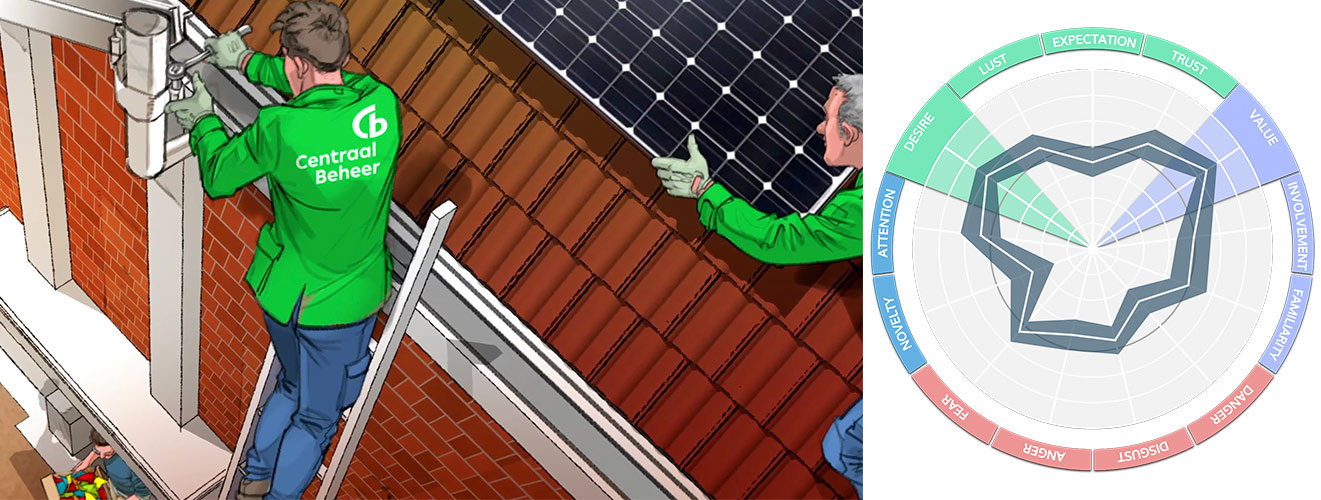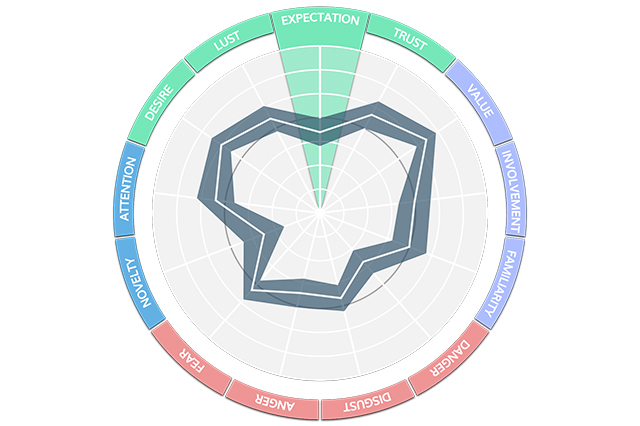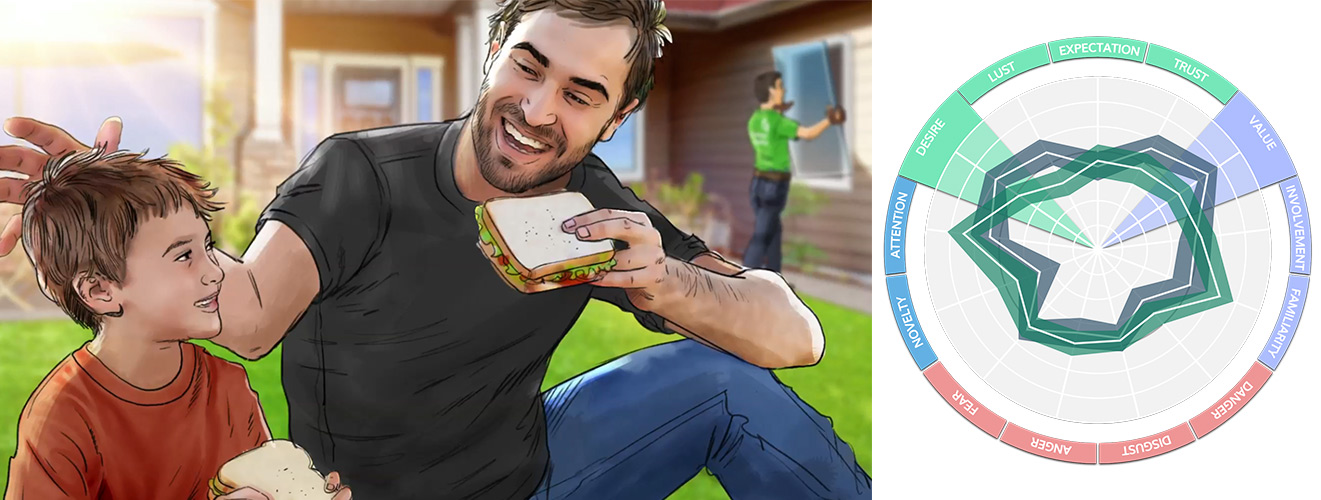"Neuro research is the solution for Centraal Beheer for pre testing ads. Neurensics translates the research insights into concrete and realistic adjustments of the advertising material which can be directly used by our advertising agency." Natasja van Buuren, Marketing Intelligence, Centraal Beheer
The new service of Centraal Beheer
Centraal Beheer is a Dutch insurance company known for their humourous ads. The humourous situations always lead to a person needing insurance from Centraal Beheer. Recently, Centraal Beheer has expanded its portfolio and became a broad service provider. Now, Centraal Beheer offers all kinds of services for households, such as help with DIY construction jobs, or advice on installation of solar panels.
To communicate the additional services well, Centraal Beheer tested two ad concepts containing its signature Centraal Beheer humour. Centraal Beheer asked two important questions:
- Which of the two humourous concepts works better?
- Which of the two concepts best communicates its recent portfolio expansion?
Concept 1: Bouncing castle
Concept 2: Trampoline
How are these ad concepts tested?
Test participants viewed the concepts in the MRI. Why? To measure the unconscious emotions and factors activated by the concepts.
These unconscious emotions and factors influence consumer behaviour. They can only be measured with fMRI, as fMRI provides access to brain regions where advertising effects are active.
What are the most important emotions and factors for consumer behaviour?
There are 13 emotions and factors relevant for consumer behaviour, such as Desire, Trust and Attention.
How do we know which emotions are effective?
The activated emotions and factors are compared with established benchmarks for Effective, Likeable and Annoying storyboards.
An effective ad strikes a good balance between positive and negative emotions, where the positive emotions persist at the end of the ad.
How are the emotions and factors further measured and interpreted?
- Eye Tracking: While participants view the concept in the MRI, their eye movements are simultaneously tracked via Eye Tracking. This provides data on elements which attract attention and elements which do not.
- Brain Guided Interpretation (BGI): As a follow-up, BGI (online questionnaires) is used to discover possible reasons emotions were activated by the concept. The combination of fMRI and questionnaires provides valuable and complete results.
Results concept 1: Bouncing Castle
fMRI: Bouncing Castle scores high on the positive emotions of Value and Desire

Bouncing Castle scores above average on the emotions: reward (Value) and attraction (Desire) (see the peaks in the green and purple areas). This indicates the activation of positive emotions. Brain Guided Interpretation (BGI) was used to discover which scenes activated these emotions:
- The scene of party preparations.
In this scene, Centraal Beheer does your chores for you, giving you time for other things. The presence of handyman is also reported as a safe choice. - The joke at the end.
In this scene, the grandpa is hanging on the rope, and it seems dangerous for a moment; but, later we see that no harm is done. Thus, viewers appreciated the joke with no prevalence of negative emotions at the end of the scene. - The final message.
Centraal Beheer communicates a clear solution to the problem: even when things go wrong, Centraal Beheer is able to resolve it with the right insurance.
fMRI - Point for improvement: Communicate the new service more clearly
Bouncing Castle scores low on the positive emotion of Expectation (see green area). We investigated the cause with BGI:
- Test participants indicated that the new services offered is unclear. More information is needed about the new service: "What kind of chores can they help you with?", "What are the costs?" and "What are the benefits?".
Details on the services should be included to increase the score on Expectation. This gave Centraal Beheer the idea to communicate the service details through other media channels to complement the TV ads.

Results concept 2: Trampoline
fMRI: Trampoline shows an imbalance of emotions, but is Likeable.

The balance of positive and negative emotions is poorer for Trampoline compared to Bouncing Castle (see the difference between the two concepts, green line = Trampoline and the grey line = Bouncing Castle). Specifically, Trampoline scores lower on Value and Desire.
Although Trampoline does not score above average ads in effectiveness (an effective concept activates more positive than negative emotions), it does score high on Likeability. BGI was used to investigate which scenes produced this likeable feeling:
- The scenes with the father and son.
Good feelings were activated when the father and son assemble the trampoline and eat a sandwich together. - Jumping on the trampoline.
Participants appreciated the scenes of father and son having fun on the trampoline. - The surprising end when the ad reveals that the trampoline is next to a cliff.
This unexpected twist is seen as a trademark of Centraal Beheer's humour and is well appreciated.
Why doesn't Trampoline activate the right balance of emotions?

To find out why the balance of emotions was not optimal in Trampoline, we looked at the fMRI timeline (see above). The fMRI timeline shows whether positive or negative emotions were activated in a scene. More positive emotions were activated if the line rises above 0 and more negative emotions were activated if the line falls below 0.
The humour in the last scene unconsciously activates negative emotions
The scene that participants consciously described as funny, actually activated unconscious negative emotions. In the very first scene where the father and son jumps on the trampoline next to the cliff, the fMRI time line drops below 0. After this, the line rises slightly to the 0-point, but not high enough. The ad even ends with the timeline below 0.
Participants do not have unconscious positive responses to the solution offered by Centraal Beheer (an insurance), because it is not an actual solution: should a person fall off the cliff, insurance wouldn't matter because the person would probably be dead.
This concept activated significantly less reward (Value) and Desire than Bouncing Castle. The Bouncing Castle concept introduces a problem - the castle floating to the sky - which can be resolved by insurance. This results in a positive ending, but Trampoline does not.
Humorous situations and Eye Tracking analysis
![]()
Eye Tracking shows that the humorous situations were observed closely.
- In Bouncing Castle, participants observed the scene where grandpa grabs the flying bouncing castle carefully. Participants also observed the distance between grandpa and the bouncing castle carefully to assess the danger in the situation.
- In Trampoline, when the cliff comes into view, participants quickly shifted their gaze to assess how deep the drop is.
As mentioned earlier, the negative emotions that were activated by Bouncing Castle were not dominant. There were sufficient positive emotions activated after the humorous scene. The concept's creators did well by compensating for the negative emotions with humour.
However, this wasn't successful for Trampoline. The danger portrayed wasn't sufficiently compensated by positive emotions. As a result, the positive emotions of Desire and Value, which are essential for consumer behaviour, are low.
Important conclusions
- Bouncing Castle had the highest score on positive emotions and uses humour in the right way.
This is because Bouncing Castle shows a problem and a solution, sufficiently compensating the negative emotions with humorous scenes, giving positive emotions. We see the castle floating to the sky (the problem) and then the message that Centraal Beheer offers insurance for the problem (the solution).
This ensured that Bouncing Castle activated sufficient positive emotions and scored highly based on the benchmark for effective storyboards.
Trampoline shows no problem (no one falls off the cliff) but if someone does fall off the cliff, an insurance from Centraal Beheer would be of no use. The danger activated by the humorous scene at the end of the concept was not sufficiently compensated by positive emotions. As a result, this concept scores lower on the benchmark of effective storyboards. - Bouncing Castle needs to communicate its new services more clearly.
Centraal Beheer resolved this by communicating details of its services through other media channels.
Advice to Centraal Beheer
The concept 'Bouncing Castle' is the clear winner with a lot of potential. The concept scored above average on the positive emotions of Desire and Value and created a good balance of all emotions.
Centraal Beheer followed our advice and chose the 'Bouncing Castle' concept. They've adapted the concept to have the father display less fear when the castle floats to the sky, in order to activate (even) less negative emotions.
Key takeaways:
- The effectiveness of humour in advertising can be tested in the concept phase
For years, Centraal Beheer has been looking for the right form of humour in their ads. Humour which is effective and activates the right balance between the negative and positive emotions.
Humour often comes in the form of glee (laughing at the expense of others) and consciously we find this funny and enjoyable. However, unconsciously, it activates negative emotions, influencing us to avoid the behaviour or situation.
That's why it is important to test the effectiveness of the humour you use in your ads, and that's exactly what we did for Centraal Beheer. - Communicate the most important message as clearly as possible
Next, think carefully about the most important message you want to communicate. It's important that it's clear for the target group. A concept test can inform you where the message is sufficiently clear. - Effective ads need to have the right balance of positive and negative emotions
The right balance between emotions makes a concept, and thus the ad, effective, assuring you that your advertising money is well spent.
And now you:
- Are you unsure about how to communicate new services or products?
- Do you want to know if your message is clear?
- Do you use humour in an effective way?
Contact us to discuss your research possibilities.







